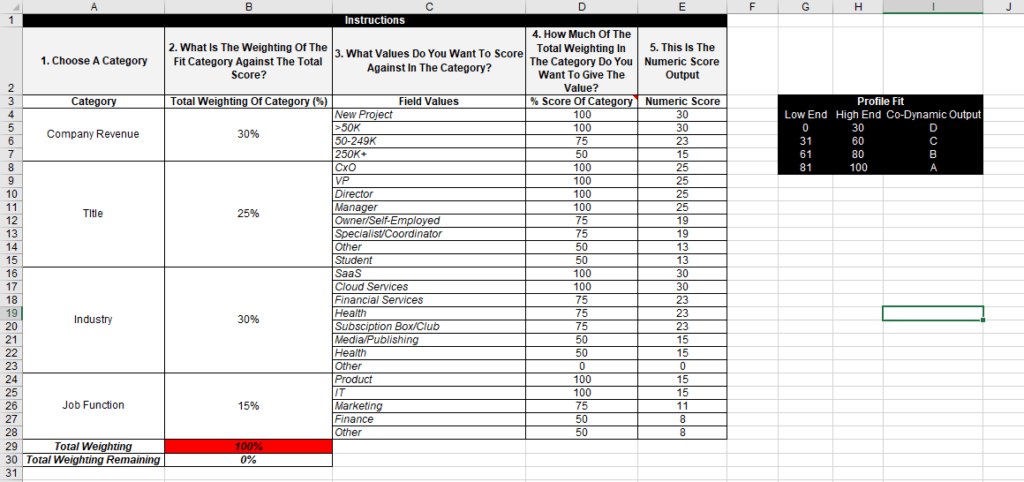Lead scoring can make the difference between closing a deal with a hot customer or wasting your time with someone who is not interested in buying from you at all.
Interestingly enough, recent research found that 64% of companies don’t even use lead scoring, and 27% have no plans for adoption. Hence, there’s a great opportunity to be ahead of your competitors if you are able to implement it.
But where to start? Finding the right lead scoring model for your business will go a long way.
If you are used to a marketing automation platform like HubSpot, Marketo, or Pardot, you know that lead scoring is a foundational feature in all these platforms. But what isn’t the same is how they interpret lead scoring, which is precisely why we are here today!
In this article, we’ll discuss what’s in a lead scoring model and how you make one, plus three different approaches to a lead scoring model–including which model to use depending on your company’s needs.
By the end of this article, you’ll know the right lead scoring model you should use to close more deals.
Let’s dive in.
What is a Lead Scoring Model?
Simply put, lead scoring models are systems that you can create to rank and prioritize leads. This process will provide several benefits.
For example, it will inform you where they are within your customer journey. This is important because, in this way, you can respond with the most appropriate action, whether it’s gently pushing them through the next step of the journey or immediately reaching out to them and closing the deal.
This is where lead scoring models come into play. Depending on which lead scoring model you use, leads that are ready to buy will be given a different name, but the idea is the same: the more they are likely to buy from you, the higher they’ll rank (or the hotter they’d be.)
Lead scoring is indeed a huge topic, and at Breadcrumbs, we have focused on the customer journey and how the recency and frequency of a user’s behavior can impact the overall value of the lead being ranked so that you can boost your company’s growth and unlock revenue acceleration.
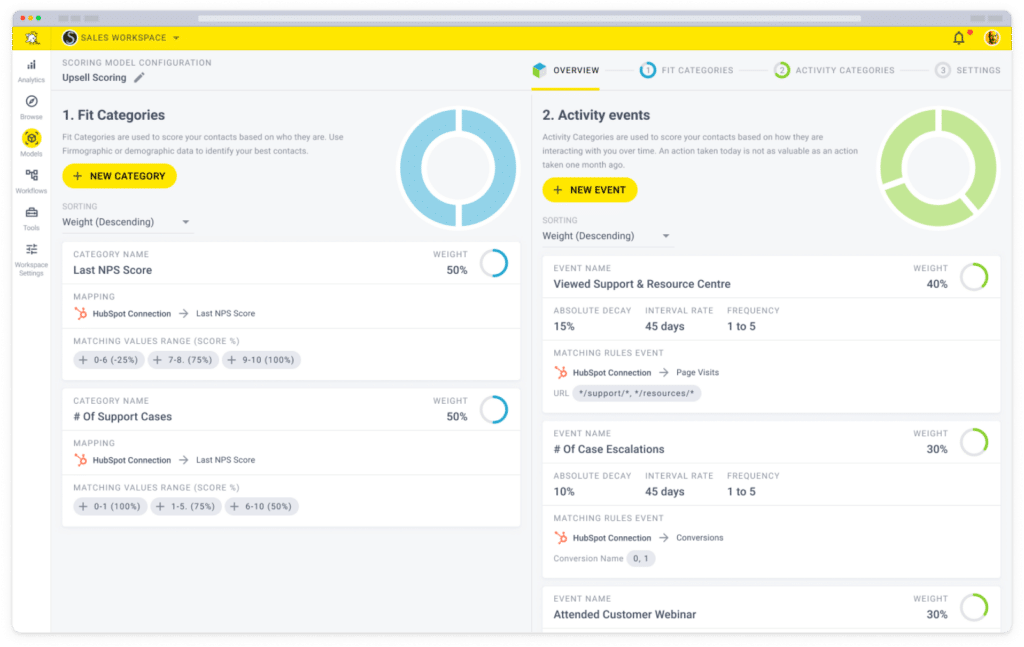
How Do You Create a Lead Scoring Model?
As you may have guessed by now, lead scoring can take many different forms… numbers, letters, and numbers, even (spoiler alert!) peppers…. before we dive into the specifics of each lead scoring model and its different forms, a little note of caution.
While the concept of lead scoring applies across all of the different types of lead scoring models we’ll describe in this article, you want to ensure that you consider the following two concepts when assessing what type of lead scoring model you want to implement for your business, whether you own B2B SaaS or if you want to start an online business.
Make lead scoring models that are easy to understand
This first point seems obvious, right? But it’s super important because different teams will be involved in analyzing the results of your lead scoring efforts–particularly your own sales reps and marketing teams.
What you’d need to ask yourself here is: will my sales team understand the quality of the lead based on the scoring output?
This is super important because you want your sales and marketing teams not only to go together well but also to be more effective and work in synergy. What if your lead scoring models can help in defining when exactly your marketing team should hand off a lead to the sales team?
Make lead scoring models with clear levels of differentiation
There’s nothing more frustrating than creating a lead scoring model, looking at the ranked leads, and not being able to determine if the result you’re staring at means your lead needs more nurturing or is ready to buy.
What you’d need to ask yourself here is: when you look at the score, can you tell the difference between a hot and cold lead?
Once you have clear levels of differentiation, the handoff and sales process again becomes smooth and easy, and your sales team won’t lose any more time trying to figure out how to prioritize the leads your marketing team is sending their way.
-
Lead Scoring vs Lead Nurturing: 7 Differences to Maximize Your Sales Funnel
Read more: Lead Scoring vs Lead Nurturing: 7 Differences to Maximize Your Sales FunnelManaging leads effectively means prospects move through the funnel efficiently, resulting in more conversions and…
Which of These 3 Lead Scoring Models Will Win You More Deals?
In the previous section, we have seen what a lead scoring model is and some key points you need to consider when choosing which approach to use for a brand-new model or reviewing an existing one.
Now, we’ll describe how to get the most out of your lead scoring models, including how each lead scoring model would look more in-depth and which model your company should be using.
There are a few different ways to articulate lead scoring models, and we will showcase three key approaches below.
Lead scoring model #1: Numeric Score Output
With this type of model, you typically output your lead score as a number.
That number is usually a mix of fit (aka ranking your lead based on their fit into your preferred demographic categories such as job title, industry, or company size) and behavior (aka ranking your lead based on engagement with you and your business) information.
The higher the number, the higher your score. And conversely, the lower the number, the lower the score.
When you use a numeric output, while it’s simple in terms of understanding, what it can do is leave you wondering how much of the score is based on the fit and how much is based on the behavior.
This is a type of model you typically see in businesses that are just getting started with lead scoring and are looking for a basic way to get started by looking at leads at a score out of 100.
This model allows your organization to get started and provides a clear level of differentiation. However, getting a clear ranking over time can become more complicated as you add more variables to your scoring matrix.
Most marketing automation platforms provide lead scoring functionality in this method.
PROS: you probably already have it in your MAP or CRM. Although setting up lead scoring systems may require some time, you don't need additional software. CONS: MAPs and CRMs (we love HubSpot, by the way!) are great, but as often happens with big products, some of the features tend to be basic (aka, you probably need additional lead scoring software to have an impact.)
Lead scoring model #2: Hot vs. Cold
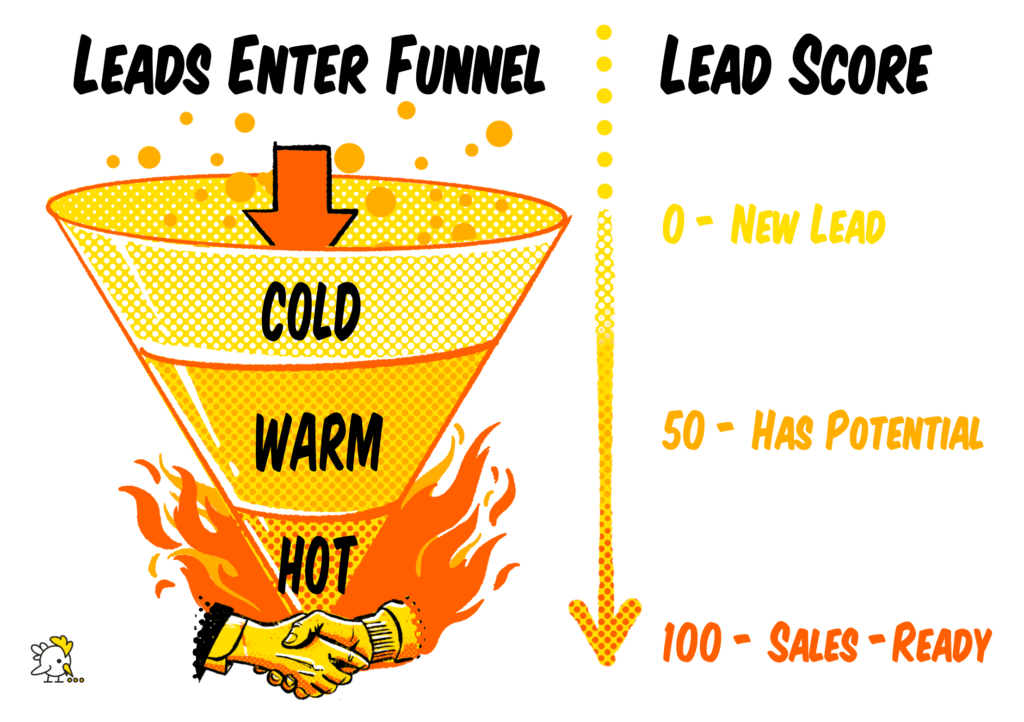
This model usually represents the higher score output by hot food or flames (or yes, peppers!), whereas cold could be an icicle.
The more hot items you have, the hotter your lead is, and conversely, the coldest items you have, the colder your lead is. This type of scoring will only focus on behavior activity and not take into consideration the fit of the lead.
This type of model is typically used by businesses that are really just looking to evaluate the activity of a lead and showcase it playfully (don’t misunderstand me; there’s nothing wrong with that).
Activity is definitely important when it comes to lead scoring. However, it doesn’t tell the whole story when it comes to the quality of the lead. The attributes of a lead, such as their industry, title, and company size, help the score better understand the overall Ideal Customer Profile (ICP) and buyer persona fit.
PROS: action means intent, and gauging potential customers' interest level is fundamental when you prioritize leads. CONS: activity and visits to high-value pages are certainly important, but you don't want to reach out to low-quality leads even if they are active (hello, ICP!)
Lead Scoring Model #3: Co-Dynamic Lead Scoring
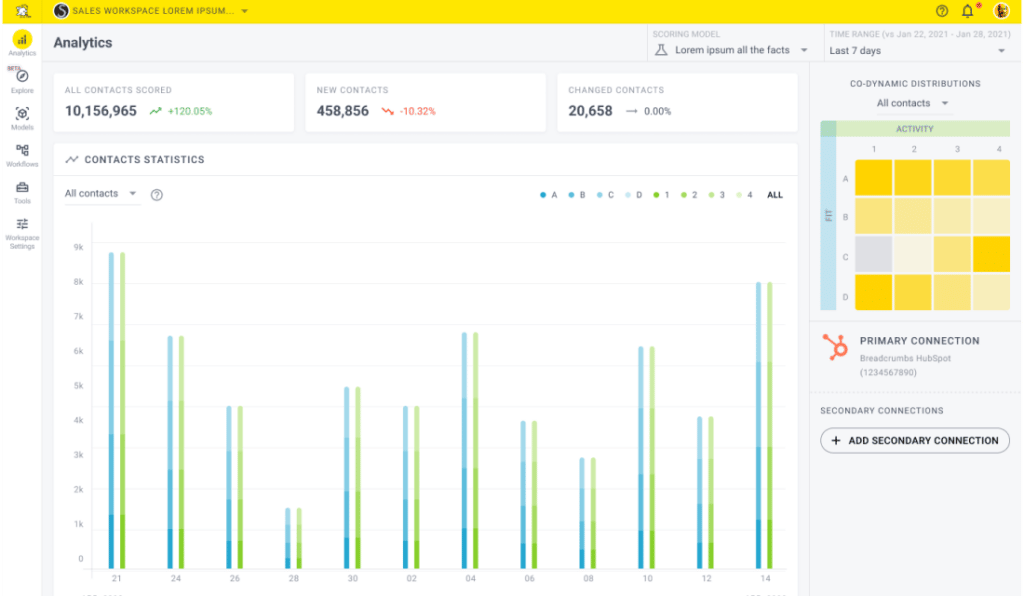
This model leverages predictive lead scoring and is probably very familiar to Breadcrumbs customers, as this is the one we use for our software.
What is predictive lead scoring?
This is where we introduce predictive lead scoring, as it is the core of our lead scoring software.
In short, predictive lead scoring is a data-driven methodology that uses machine learning and predictive modeling algorithms to analyze historical and customer activity data, thereby identifying qualified leads that are most likely to convert into paying customers.
Predictive scoring generates a score for each lead, reflecting the perceived value and the probability of a contact closing as a customer within a certain time frame, which helps in prioritizing and qualifying leads, and achieving higher lead qualification rates.
With this model, the lead score is broken out into a letter and a number.
The letter represents the level of fit the lead has and is articulated as either A, B, C, or D–where A is the highest fit and D is the lowest.
The number represents the level of engagement a lead has and is articulated as either 1, 2, 3, or 4–where 1 is the highest level of engagement and 4 is the lowest.
Sounds complicated, but it really isn’t. While this model typically has 16 different variations of lead scoring, it provides a very easy way to understand both the quality of the fit and the right type of engagement.
Companies employing a co-dynamic lead scoring model typically understand who their buyers are and what activities indicate buying behavior. They see the benefits of understanding both what the prospect does and who they are.
PROS: co-dynamic lead scoring allows you to be very specific about who your qualified leads are, where they are in the sales funnel, and what type of engagement they have shown. When using software that was built with co-dynamic lead scoring in mind, you can also track multiple touchpoints to see how leads are behaving across different channels and campaigns. CONS: this model may require upfront work to set up and maintain. You generally need to have a good understanding of your target audience and their buying behavior in order to accurately score leads. Additionally, if your company's business strategy or target audience changes, you may need to adjust your lead scoring model accordingly.
What if there was a lead scoring tool that looks at your data points and reveals the ones that make the biggest impact on conversions in just a few clicks using machine learning?
Enter Breadcrumbs: you can easily identify and prioritize your hottest leads for better targeting and sales efforts. You no longer have to guess which leads are more likely to convert–let our algorithm do the heavy lifting for you.
Let’s see how this works in practice.
How Does Breadcrumbs’ Lead Scoring Process Work?
Breadcrumbs considers both fit (how well a lead matches your ideal customer profile) and activity (the lead’s level of engagement with your brand). This dual consideration provides a more holistic view of a lead’s potential value, allowing you to prioritize your marketing and sales efforts better.
But what should you expect when starting out with Breadcrumbs?
Disclaimer: we wrote an in-depth, step-by-step Breadcrumbs lead scoring guide to help you better understand how Breadcrumbs works.
Here’s the TL;DR:
When using Breadcrumbs, your sales team doesn’t need to learn complicated lead scoring tools or systems or manually assign points or score leads. All they need to do is:
- Connect data sources (CRM, MAP, product analytics, you name it)
- Run a Reveal analysis to analyze customer data against your best leads (it starts automatically once data sources are connected)
- Create a data-driven scoring model using the best fit and activity categories with Copilot (it just takes a few clicks)
- Launch your scoring model in test mode and adjust it as needed (plus test as many hypotheses as you have for all your verticals, products, and geographies)
- Launch your scoring model in production and start scoring your leads automatically!
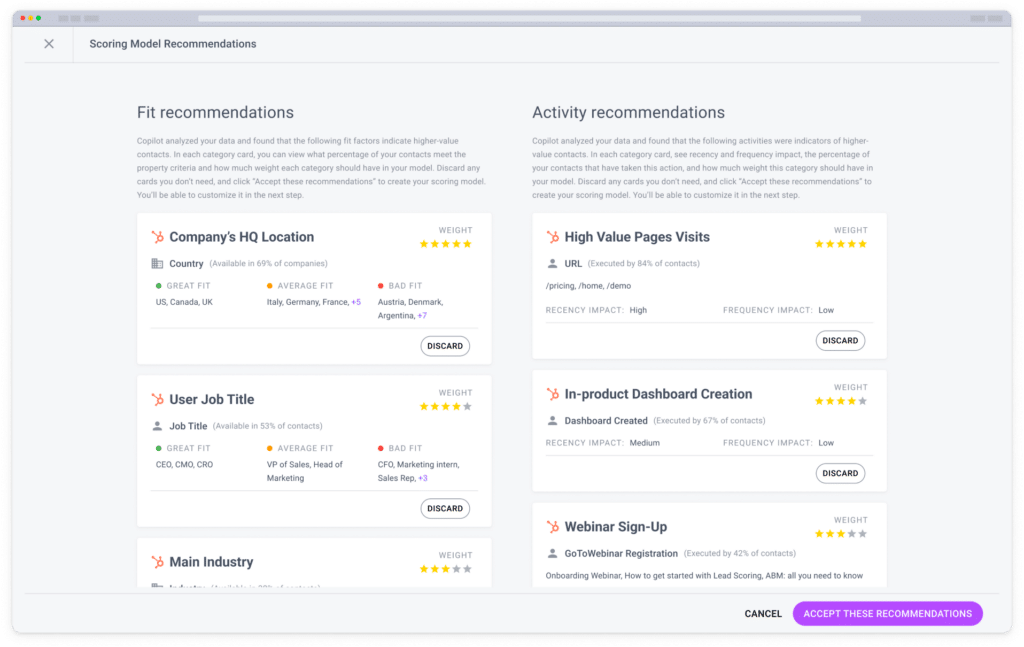
In this article, we discussed what’s in a lead scoring model and how you make one and three different approaches to a lead scoring model–including what we believe is the best approach to lead scoring–so that by the end of this page, you’ll know the right lead scoring model to use for your business to close more deals.
Now, back to you! What is the most effective lead scoring model you have used and why? Let us know in the comments below.
Happy scoring!
Sign up for free with Breadcrumbs to get started with your lead scoring model today, or use our intuitive model builder, Copilot, to create an entirely custom one.




